
 |
Tea Clipper |
 |
| from TeaAntiques.com | ||
| Edition Eleven |
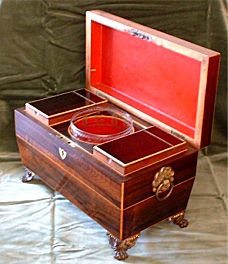 My antique of
the month is a very beautiful and decorative Regency rosewood tea caddy, c1820.
It is typical of the Regency style being of Sarcophagus shape, with charming
ormolu drop handle mounts and shaped lion paw feet. The caddy is boxwood strung
and inside has two removable tea canisters, used for green and black teas. In
the centre is a charming contemporary glass mixing bowl etched with foliage
around its rim. The caddy is red paper lined and in lovely condition and having
a working two lever brass lock and key.
My antique of
the month is a very beautiful and decorative Regency rosewood tea caddy, c1820.
It is typical of the Regency style being of Sarcophagus shape, with charming
ormolu drop handle mounts and shaped lion paw feet. The caddy is boxwood strung
and inside has two removable tea canisters, used for green and black teas. In
the centre is a charming contemporary glass mixing bowl etched with foliage
around its rim. The caddy is red paper lined and in lovely condition and having
a working two lever brass lock and key.
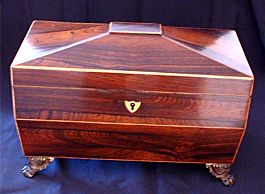 This is a
very fine example of a Rosewood veneered tea caddy and can be viewed on the
TeaAntiques web site. It was worth the efforts of the Cutty Sark and other such
tea trading ships, to bring back those precious teas with which to fill these
handsome tea caddies for our delectation.
This is a
very fine example of a Rosewood veneered tea caddy and can be viewed on the
TeaAntiques web site. It was worth the efforts of the Cutty Sark and other such
tea trading ships, to bring back those precious teas with which to fill these
handsome tea caddies for our delectation.
More details of this item and other tea related antiques can be found by visiting my web site at www.TeaAntiques.com.
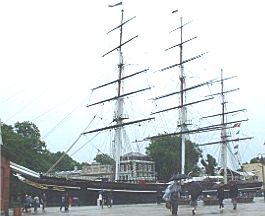 This month it
is time to visit Greenwich, East London in England and review the famous Cutty
Sark 'tea clipper' ship.
This month it
is time to visit Greenwich, East London in England and review the famous Cutty
Sark 'tea clipper' ship.
Tea Clipper ships (from which this newsletter has taken its name), were used in the nineteenth century as the most swift method of bringing the much favoured and delicious teas from China.
 Tea was in
great demand in England, the race to bring the fresh new season's tea back from
China saw tea clippers competing to be the first back with their precious cargo.
In much the same way as horse racing today, the china tea race was the means for
huge bets and sums of money to be placed on potential winners. Often the crews
would bet their wages, so risking their finances as well as their lives during
the perilous voyage.
Tea was in
great demand in England, the race to bring the fresh new season's tea back from
China saw tea clippers competing to be the first back with their precious cargo.
In much the same way as horse racing today, the china tea race was the means for
huge bets and sums of money to be placed on potential winners. Often the crews
would bet their wages, so risking their finances as well as their lives during
the perilous voyage.
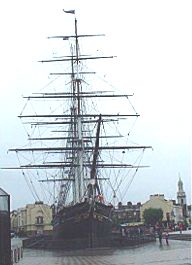 The Cutty
Sark was one such tea clipper, although she came into service rather late in the
tea race, her maiden voyage being 1870, her last tea run was just seven years
later in 1877. One factor that saw the decline in the use of sailing ships was
the opening of the Suez canal in 1869, this enabled steam ships to take part in
the tea trade, with a vastly reduced journey and avoiding the treacherous Cape.
Tea clippers still continued their service, the tea trade had grown considerably
in size providing room for both sorts of vessel to operate.
The Cutty
Sark was one such tea clipper, although she came into service rather late in the
tea race, her maiden voyage being 1870, her last tea run was just seven years
later in 1877. One factor that saw the decline in the use of sailing ships was
the opening of the Suez canal in 1869, this enabled steam ships to take part in
the tea trade, with a vastly reduced journey and avoiding the treacherous Cape.
Tea clippers still continued their service, the tea trade had grown considerably
in size providing room for both sorts of vessel to operate.
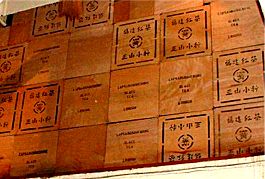 The journey
time for the tea clippers to bring tea from China to the docks of London was
about 100 days, their hulls would be packed tight with tea chests.
The journey
time for the tea clippers to bring tea from China to the docks of London was
about 100 days, their hulls would be packed tight with tea chests.
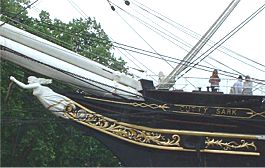 Until 1849, much
slower ships had been used for the tea trade, but in 1849 the 'navigation act',
which had protected their trade was repealed. This now meant that American
cotton trade clippers could take part. English ship builders were swift to copy
and improve on the clipper designs and won the battle for the trade. By the
1860's there were no more cotton clippers in the running.
Until 1849, much
slower ships had been used for the tea trade, but in 1849 the 'navigation act',
which had protected their trade was repealed. This now meant that American
cotton trade clippers could take part. English ship builders were swift to copy
and improve on the clipper designs and won the battle for the trade. By the
1860's there were no more cotton clippers in the running.
Tea Clipper captains took great pride in their ships, which were seen to well looked after with gleaming paint work and brass fixtures.
The Cutty Sark is now in a dry dock in Greenwich and open to the public as a museum. Entrance to the ship takes the visitor onto the 'tween deck (between the main decks above and the hold below). This has several information boards guiding the visitor through the story of the tea and tea clipper trade.
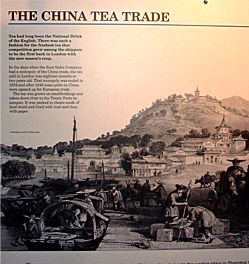
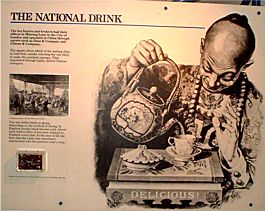
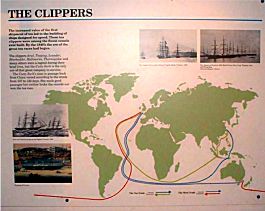
These information boards are very informative and worth while standing to read them before continuing the tour of the rest of the ship.
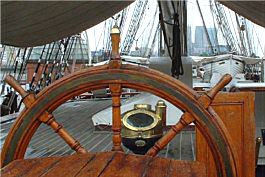
From the 'tween deck you take the steps up to the main deck above. From here
you can walk around the deck with good views across Greenwich and the Thames. At
the stern, near to the ship's wheel, is the officers' accommodation. In the
saloon is a wooden table with wooden benches down either side.
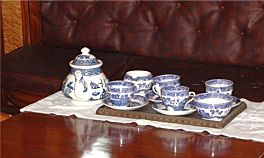 This table was used for officers' meals and also as a map table for charting
their passage. It had been set now with a rather modern looking 'willow pattern'
tea service!
This table was used for officers' meals and also as a map table for charting
their passage. It had been set now with a rather modern looking 'willow pattern'
tea service!
Within the officers' quarters are the officers' pantry, 1st mate's cabin, cabin of the ship's steward and the 2nd mate's cabin. There is also the ship's master's cabin. Although not large they did look quite comfortable and neatly furnished. The pantry was only used to serve officers food, the cooking was done in the ship's galley in a completely separate area further forward along the deck.
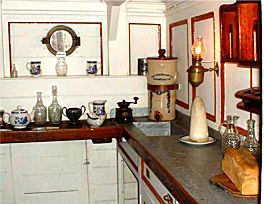
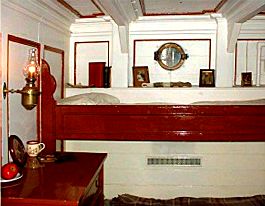
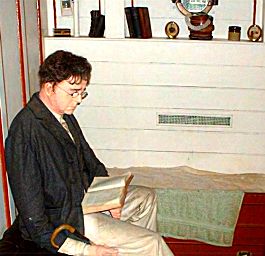 Space was at
a premium, so there was not much chance to take personal belongs with you on the
long tea trade voyage. Living accommodation had to be restricted, as there
needed to be as much space as possible for the tea storage. After all, this was
certainly no pleasure cruise!
Space was at
a premium, so there was not much chance to take personal belongs with you on the
long tea trade voyage. Living accommodation had to be restricted, as there
needed to be as much space as possible for the tea storage. After all, this was
certainly no pleasure cruise!
The rest of the crew, made up of the ship's apprentices, carpenter, bo'sun, sail maker and cook were hosed in another separate accommodation area situated near the middle of the deck. Needless to say, their accommodation was a bit more cramped than that of the officers.
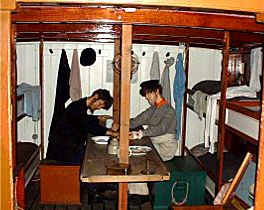 Here the men
would have their own small wooden chest to use for their belongings, this chest
would double up as a useful seat for them when sat at the table in the middle of
their cabin.
Here the men
would have their own small wooden chest to use for their belongings, this chest
would double up as a useful seat for them when sat at the table in the middle of
their cabin.
The ship has been carefully restored and the museum exhibits clearly the life on board such vessels. In addition, in the lower hold, which would have been the storage area for the tea, there is an exhibition devoted to the carved ships figureheads. These large carved heads were situated at the bow of the ship below the bow spit.
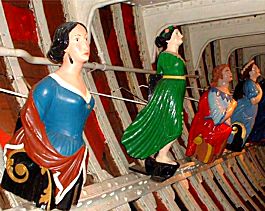 There is a
great variety in the figure heads on display, some depicting famous people and
characters. The collection is one of the finest collections of merchant ship
figure heads. There is a video showing in this area with black and white footage
of Tea Clippers at sea, taken during the 1920's, years after they had finished
active service, but providing a wonderful insight of square riggers at sea.
There is a
great variety in the figure heads on display, some depicting famous people and
characters. The collection is one of the finest collections of merchant ship
figure heads. There is a video showing in this area with black and white footage
of Tea Clippers at sea, taken during the 1920's, years after they had finished
active service, but providing a wonderful insight of square riggers at sea.
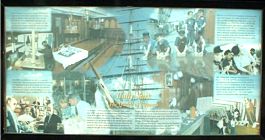 The Cutty Sark
museum is a must for the lover of tea and history of the tea trade in England.
It provides a good picture of the efforts and dangers involved in the supply of
teas for the enjoyment of those who could afford it!
The Cutty Sark
museum is a must for the lover of tea and history of the tea trade in England.
It provides a good picture of the efforts and dangers involved in the supply of
teas for the enjoyment of those who could afford it!
Whilst in Greenwich another most interesting place to visit is the 'fan museum', dedicated to the history of the fan. Most exquisitely made and decorative fans were used by ladies to 'keep their cool' in the eighteenth and nineteenth centuries. In fact, not only were they used to fan ones self to keep cool or to stop those blushes, they were also very cleverly used in such a way as to provide signals to others. Signals were be made by the way in which the fan was held, waved or the speed at which one would fan. From these signals one could quite clearly make your intentions know, such as 'I am a married woman', 'I am available for an assignation' or that 'I am angry'.
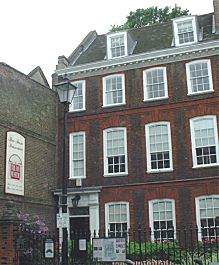 The museum is
housed within a delightful period town house, but a short walk from the Cutty
Sark. The exhibition is quite breath taking. Also, I would recommend the museums
afternoon tea, which is taken in the 'orangery' tearoom at the rear. The tea and
service is excellent and good value, serving cream teas with cakes. The orangery
itself is beautifully and cleverly painted the walls having Trompe L'oeil scenes.
The museum is
housed within a delightful period town house, but a short walk from the Cutty
Sark. The exhibition is quite breath taking. Also, I would recommend the museums
afternoon tea, which is taken in the 'orangery' tearoom at the rear. The tea and
service is excellent and good value, serving cream teas with cakes. The orangery
itself is beautifully and cleverly painted the walls having Trompe L'oeil scenes.
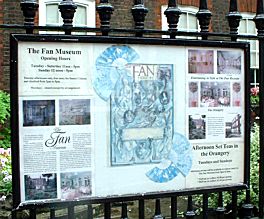 Fans were
not the only method of signing in the eighteenth century. The teaspoon could be
used to provide the indication at afternoon tea that you were replete and
required that your cup not be refilled. How was this done? Simple, you would
place the spoon into the empty cup, the host would then be aware that you had
taken your fill of tea. Does not seem to work these days!
Fans were
not the only method of signing in the eighteenth century. The teaspoon could be
used to provide the indication at afternoon tea that you were replete and
required that your cup not be refilled. How was this done? Simple, you would
place the spoon into the empty cup, the host would then be aware that you had
taken your fill of tea. Does not seem to work these days!
Osterley Park is situated on the west side of London, the other side from Greenwich and the Cutty Sark, almost in the country! This is a very grand house indeed and well worth while paying a visit.
The house was an Elizabethan house, completely remodelled by the famous Robert Adam. He threw a classical portico across the front linking the two wings. He also designed the complete interior, providing very elaborately decorated rooms and en suite furniture also to his designs.
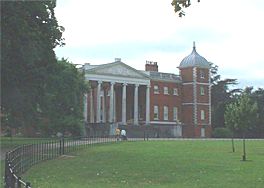
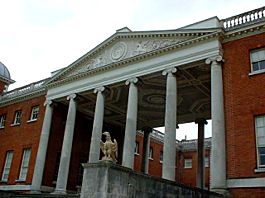
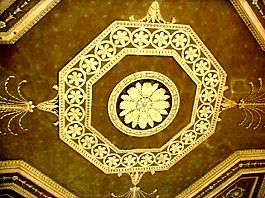 The motifs
used by Robert Adam are clearly seen on the underside of the entrance portico,
bringing a light and delicate feel to this impressive house. Such decoration is
used to great effect within the house. It is wonderful to see a house of this
period, the third quarter of the eighteenth century, retain its original feel
and the original furniture set as just as it would have been then. There are no
cluttered rooms, the furniture arranged against the room walls in a formal
fashion.
The motifs
used by Robert Adam are clearly seen on the underside of the entrance portico,
bringing a light and delicate feel to this impressive house. Such decoration is
used to great effect within the house. It is wonderful to see a house of this
period, the third quarter of the eighteenth century, retain its original feel
and the original furniture set as just as it would have been then. There are no
cluttered rooms, the furniture arranged against the room walls in a formal
fashion.
The principle rooms are magnificent, especially the state rooms, the long gallery, saloon and the tapestry room. The Tapestry room is a joy to behold, taking more than three years to complete! The tapestries were ordered from France to the exact sizes and shapes required as well as to specific decoration requirements. The result is breath taking. The condition and colour of these pink ground tapestries is remarkable. Not only were tapestries commissioned for the walls but for the coverings of the French style English gilt wood saloon furniture.
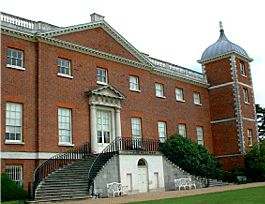
The state bed is also something to marvel over, its huge canopy bedecked with garlands of silk flowers. This may appear at first glance to be the usual four poster bed, but in point of fact it's an eight poster, with twin columns at each of the four corners.
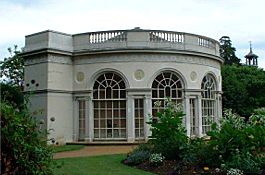
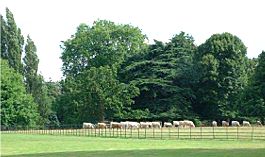 The house is
set in a very pleasant park, hard to imagine that you are on the edge of London
and very near to Heathrow airport! Within the grounds are pleasant walks taking
you through past the old orangery and other garden temples. The views across the
grounds with cows roaming but a short distance from the house, one congers up a
picture of the idyllic English landscape.
The house is
set in a very pleasant park, hard to imagine that you are on the edge of London
and very near to Heathrow airport! Within the grounds are pleasant walks taking
you through past the old orangery and other garden temples. The views across the
grounds with cows roaming but a short distance from the house, one congers up a
picture of the idyllic English landscape.
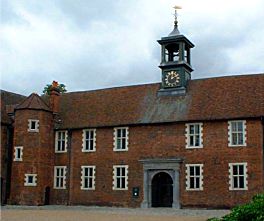
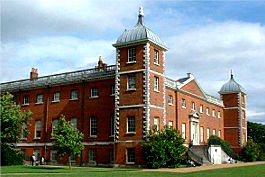 The
house is now administered by the National Trust and is open to the public during
the summer months. The old stable block with its clock tower, now forms the
restaurant. Here the visitor can take lunch or tea in the converted sables or
out in a rear courtyard garden, a pleasant way to end a tour of the house.
The
house is now administered by the National Trust and is open to the public during
the summer months. The old stable block with its clock tower, now forms the
restaurant. Here the visitor can take lunch or tea in the converted sables or
out in a rear courtyard garden, a pleasant way to end a tour of the house.
To review past newsletters, just follow this link:
Past newsletters.
To subscribe to this free newsletter -
Click here